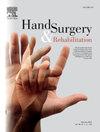Examen clinique versus électromyographie dans les lésions traumatiques du plexus brachial chez l’adulte — Analyse de la précision diagnostique
IF 0.9
4区 医学
Q4 ORTHOPEDICS
引用次数: 0
Abstract
Traumatic brachial plexus injury is one of the most devastating injuries of the upper arm, with great functional, psychological and socioeconomical impact. Evaluation includes a detailed physical examination, imagistic and electrodiagnostic studies. The purpose of this study was to determine the efficacy of preoperatory EMG examination versus physical testing of patients with traumatic brachial plexus injury when comparing with intraoperative findings.
The medical records of 36 patients with traumatic brachial plexus injury from 2020 until 2023 were reviewed. Initially the patients underwent a detailed clinical examination. Then, they were subjected to routine EMG. All of them underwent surgical exploration and the intraoperative findings were correlated. A statistical analysis was performed and P-values < 0.05 were considered statistically significant.
When used alone, clinical examination and routine EMG could not locate the site of the lesion in 3 of 36 and 20 of 36 patients, respectively. The surgical explorations have confirmed 44.44% of EMG results while the physical tests were accurate in 91.66% of cases. Moreover, the predictive rate of EMG alone is low (R2 = 10.61%), while the clinical tests alone are very useful if well performed (R2 = 84.16%). When used together, the predictive rate doesn’t modify significantly but remains at a high level (R2 = 84.28%).
Although there is a consensus that one should not rely only on one type of preoperative evaluation alone but to a combination of clinical examination, electrodiagnostic studies and imaging investigations, problems in diagnosis continue to arise. Previous studies indicate that physical examination is a very accurate tool for assessing the localisation of brachial plexus lesions and suggest that when electrodiagnostic studies and MRI are used in conjunction with it, the diagnostic accuracy is clearly improved. Our study shows that when used together, EMG and physical examination together don’t improve diagnostic accuracy. We have proven that muscle testing, if it is performed by a trained and experienced hand surgeon, can correctly identify the site of the lesion in most of cases and has the highest predictive value. Otherwise, when using EMG alone, the predictability drops to a surprising percentage.
Physical examination is probably the most accurate tool for assessing brachial plexus lesions. When used together, EMG and physical examination together don’t significantly improve diagnostic accuracy. The EMG becomes less reliable in cases of extended upper plexus and total plexus; therefore, the gold standard in detecting the site of the lesions remains surgical exploration with intraoperative neurostimulation.
求助全文
约1分钟内获得全文
求助全文
来源期刊

Hand Surgery & Rehabilitation
Medicine-Surgery
CiteScore
1.70
自引率
27.30%
发文量
0
审稿时长
49 days
期刊介绍:
As the official publication of the French, Belgian and Swiss Societies for Surgery of the Hand, as well as of the French Society of Rehabilitation of the Hand & Upper Limb, ''Hand Surgery and Rehabilitation'' - formerly named "Chirurgie de la Main" - publishes original articles, literature reviews, technical notes, and clinical cases. It is indexed in the main international databases (including Medline). Initially a platform for French-speaking hand surgeons, the journal will now publish its articles in English to disseminate its author''s scientific findings more widely. The journal also includes a biannual supplement in French, the monograph of the French Society for Surgery of the Hand, where comprehensive reviews in the fields of hand, peripheral nerve and upper limb surgery are presented.
Organe officiel de la Société française de chirurgie de la main, de la Société française de Rééducation de la main (SFRM-GEMMSOR), de la Société suisse de chirurgie de la main et du Belgian Hand Group, indexée dans les grandes bases de données internationales (Medline, Embase, Pascal, Scopus), Hand Surgery and Rehabilitation - anciennement titrée Chirurgie de la main - publie des articles originaux, des revues de la littérature, des notes techniques, des cas clinique. Initialement plateforme d''expression francophone de la spécialité, la revue s''oriente désormais vers l''anglais pour devenir une référence scientifique et de formation de la spécialité en France et en Europe. Avec 6 publications en anglais par an, la revue comprend également un supplément biannuel, la monographie du GEM, où sont présentées en français, des mises au point complètes dans les domaines de la chirurgie de la main, des nerfs périphériques et du membre supérieur.
 求助内容:
求助内容: 应助结果提醒方式:
应助结果提醒方式:


